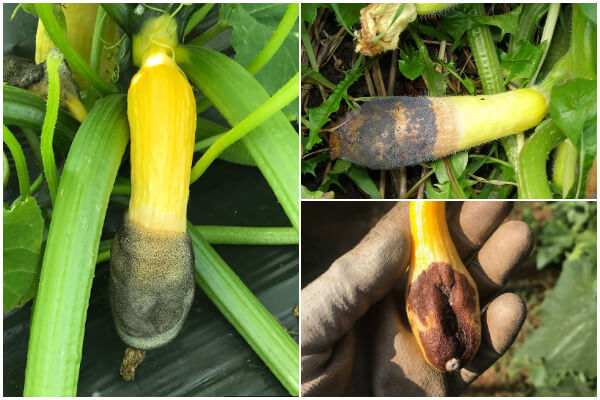Growing zucchini can be incredibly rewarding, but it can also come with challenges. One of the most common issues gardeners face is blossom end rot—a condition that leaves your zucchinis with unsightly dark, sunken spots at the blossom end, rendering the fruit unusable. The good news is that this problem can be both fixed and prevented with a few proactive steps.
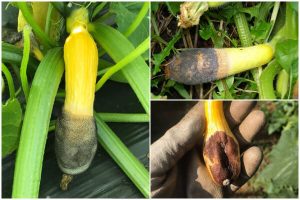
In this comprehensive guide, we’ll explore what causes zucchini blossom end rot, how to fix it, and the best practices to prevent it from happening again.
What is Blossom End Rot?
Blossom end rot (BER) is a physiological disorder that occurs when zucchinis and other fruits, such as tomatoes or peppers, suffer from a localized calcium deficiency during fruit development. Despite being called “rot,” it is not caused by pests or diseases but is instead a result of environmental and nutritional factors.
The condition typically manifests as a small, water-soaked spot at the blossom end of the fruit, which eventually enlarges, turns dark, and becomes leathery. This rotting makes the zucchini unfit for consumption and often frustrates gardeners, especially when it affects a significant portion of their harvest.
Causes of Zucchini Blossom End Rot
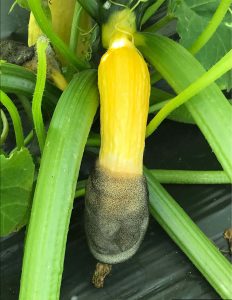
Understanding the underlying causes is essential for addressing blossom end rot effectively. Here are the main culprits:
- Calcium Deficiency in the Fruit
Calcium is vital for healthy cell wall formation in zucchinis. When there is insufficient calcium in the fruit, the tissues at the blossom end break down, leading to rot. - Inconsistent Watering
Irregular watering is one of the most common causes of blossom end rot. Periods of drought followed by overwatering can disrupt the plant’s ability to absorb and transport calcium. - Soil Imbalance
- Low Soil Calcium Levels: If the soil naturally lacks calcium, your plants won’t receive enough of this critical nutrient.
- pH Problems: Calcium availability decreases if the soil is too acidic (pH below 6.0) or too alkaline (pH above 7.5).
- Excessive Nitrogen Fertilizer
Fertilizers high in nitrogen promote vigorous leaf growth at the expense of fruit development. This imbalance reduces calcium uptake by the plant’s fruits. - Environmental Stress
High temperatures, excessive wind, and sudden changes in weather can place stress on zucchini plants, further limiting calcium uptake. - Root Damage
Poorly developed or damaged roots—caused by pests, diseases, or improper transplanting—can interfere with nutrient absorption.
How to Fix Zucchini Blossom End Rot
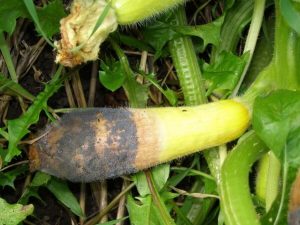
If you notice blossom end rot on your zucchini, don’t panic. Here’s how to address the problem step by step:
1. Test and Amend Your Soil
- Use a soil test kit to measure calcium levels and pH.
- If calcium is deficient, add a calcium amendment such as agricultural lime, gypsum, or crushed eggshells. These provide a long-term solution by enriching the soil.
- Adjust soil pH as needed:
- For acidic soils, apply lime to raise the pH.
- For alkaline soils, add sulfur or organic matter like compost.
2. Apply a Calcium Spray
- For immediate results, use a calcium foliar spray, which is absorbed directly through the leaves and fruit.
- These sprays can be purchased at garden centers or made at home using dissolved calcium chloride.
3. Water Consistently
- Provide deep, even watering to maintain consistent soil moisture. Watering at the base of the plant prevents splashing and reduces disease risks.
- Mulch your zucchini plants with organic materials like straw or wood chips. Mulch helps retain soil moisture and prevents rapid drying.
4. Reduce Nitrogen Fertilizer
- Switch to a balanced fertilizer, such as one with an N-P-K ratio of 10-10-10, to support fruit development without overwhelming the plant with foliage growth.
5. Protect the Roots
- Avoid disturbing the soil around your zucchini plants. Damaged roots are less effective at nutrient uptake.
- Keep an eye out for root-damaging pests like nematodes or grubs and treat infestations promptly with natural or chemical remedies.
Preventing Zucchini Blossom End Rot
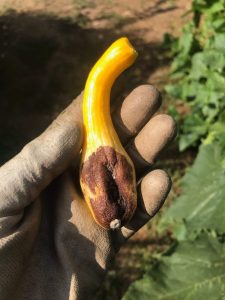
Prevention is always better than cure, and the following tips will help you grow healthy zucchinis without worrying about blossom end rot:
1. Start with Healthy Soil
- Before planting, enrich your soil with plenty of organic matter like compost or well-rotted manure. This improves soil structure and ensures steady nutrient availability.
2. Maintain Consistent Moisture
- Aim for 1 to 1.5 inches of water per week, either through rainfall or irrigation.
- Drip irrigation systems or soaker hoses are excellent tools for maintaining consistent soil moisture.
3. Choose Resistant Varieties
Some zucchini varieties are less prone to blossom end rot. Look for cultivars labeled as “drought-resistant” or “blossom end rot-resistant” when selecting seeds or seedlings.
4. Monitor for Early Signs
- Regularly inspect your plants for signs of blossom end rot. Catching it early allows you to take immediate corrective action.
5. Avoid Plant Stress
- Provide shade during extreme heat to prevent stress.
- Space plants adequately to ensure good airflow and reduce competition for nutrients.
6. Incorporate Companion Plants
- Planting beans or peas near zucchinis can improve soil nitrogen levels naturally, helping to create a balanced nutrient environment for your zucchinis.
Common Misconceptions About Blossom End Rot
- “It’s caused by pests or diseases.”
Blossom end rot is purely a physiological issue and not related to pests or pathogens. - “Adding calcium always fixes the problem.”
While calcium is essential, the underlying issue is often inconsistent watering, which limits calcium uptake. Addressing water management is just as crucial as adding calcium. - “Only young fruits are affected.”
While blossom end rot is more common in young fruits, mature zucchinis can also suffer if the plant faces stress during development.
Blossom end rot isn’t just an aesthetic issue—it directly impacts your zucchini harvest. If left untreated, it can reduce yield, waste your gardening efforts, and discourage you from growing zucchinis altogether. Addressing the issue promptly not only ensures a healthier harvest but also enhances your gardening skills for future seasons.
Fixing zucchini blossom end rot is achievable with a combination of good soil management, consistent watering, and attention to plant health. By addressing the root causes and following preventative measures, you can enjoy a bountiful harvest of zucchinis that are free from this frustrating condition.
With these tips and strategies, your zucchini plants will thrive, providing you with fresh, delicious vegetables all season long. Happy gardening!

